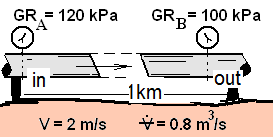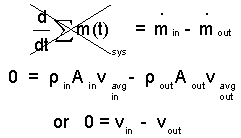| THERMO Spoken Here! ~ J. Pohl © | TOC NEXT ~ 245 |
Pipeline Flow

The sketch shows a section of a pipeline through which oil flows steadily left to right. Two sections, "A" and "B", are indicated as vertical planes cutting through the pipe. Take the system to be the oil contained within the pipe between the "in" and "out" planes. Masses of oil flow across these planes.
What does the energy equation say about the flow of this physical situation?
♦ One approach to an answer would be to think about this situation then write down the abbreviated, relevant terms only, form of the energy equation. A second path is to write the energy equation we have developed in its entirety; then by inspection of the system (with reflection) strike out terms as zero ( X ) or small ( / ) to arrive at a suitable energy equation. Although the second approach involves more writing, to use it consistently, is to start every problem with the same equation. The energy equation we have developed (one of the system equations) is general. Our choice in to begin every energy analysis with that equation; things move faster with experience.
♦ For steady operation, nothing changes in time therefore any term differentiated with respect to time (that is, preceded by d / dt equals zero. Consequently, the following terms, being zero, are struck out.

| (1)1 |
Rate of extrinsic energy change occurs directly as does the rate of extrinsic work. When one is zero, so also is the other.

| (2) 2 |
There is no source of power between the sections. The flow having been established for a long time; 0 = ΣQ. Being a single stream, the Σ's do not apply. With these adjustments, our reduced energy equation becomes:

| (3) 3 |
Typically, when doing an energy analysis, one starts with the energy equation. The mass equation is needed also but, being easier, it is often used secondly. There is a single stream of flow with constant density and constant flow area.

| (4) 4 |
Thus the entering and leaving kinetic energies of the flow are equal. And since the elevation is constant, entering and leaving potential energies are equal.

| (5) 5 |
When a gas is flowing we address the enthalpy difference of the entering and leaving streams. When the substance is a liquid we apply the substitution, h = u - pv .

| (6) 6 |
Upon its definition, internal energy was considered a dependent property with temperature and specific volume as its independent variables, u = u(T,v). The flow is incompressible, meaning vin = vout. Also there being no heating mechanism, the entering and leaving temperatures are equal (or near so). Our reduced equation is:

| (7)7 |
The resulting equation has four terms. Term (1) has the numeric value "0." The thermodynamic meaning of this "0" is the system energy is constant in time. Also and obviously, the "0" means the right-of-equality terms sum to zero. Terms (2) and (3) represent energy entering and leaving the pipe with the mass flow. More energy enters than leaves. Energy is dissipated frictionally (internal mechanical equilibration) as it flows.
Calculate the frictional power loss of the flow.
♦ Notice, when friction is assumed equal to zero, the energy equation, Eqn-7, states that the upstream and downstream pressures of the flow are equal. This is equivalent to the idea that water flows for free.

Pipe Line Flow
The sketch shows a section of a pipeline. Oil flows through the pipe steadily. Two sections (planes that cut through the pipe) are identified. Take the system to be the oil contained within the pipe between the "in" and "out" planes. Masses of oil flow across these planes.
What does the energy equation say about the flow of this physical situation?
Premise presently unwritted!